- Home
- Devdutt Pattanaik
Devlok With Devdutt Pattanaik
Devlok With Devdutt Pattanaik Read online
DEVDUTT PATTANAIK
DEVLOK with Devdutt Pattanaik 2
PENGUIN BOOKS
Contents
1. Dhyan and Darshan
2. Amrita Manthan
3. Forest and Field
4. Astik–Nastik
5. The Surya Vansh and the Chandra Vansh
6. Atma
7. Haldi, Kumkum, Chandan, Bhasm
8. Hanuman
9. Jagannath Temple of Puri
10. Elephants
11. Rama’s Ancestors
12. Mountains
13. Karna
14. Years in Exile
15. Vedic Gods and Goddesses
16. Vrata
17. Storytellers of the Ramayana and the Mahabharata
18. Lakshmi and Saraswati
19. Mothers
20. Women in the Mahabharata
21. Varaha and Narasimha
22. Varna
23. Sita and Draupadi
24. Brothers and Sisters
25. Characters from the Ramayana in the Mahabharata
26. Harishchandra
27. Aarti and Toran
28. Women in the Ramayana
29. Uttara Ramayana
30. Yayati
Footnotes
22. Varna
Author’s Note
Follow Penguin
Copyright
PENGUIN BOOKS
DEVLOK WITH DEVDUTT PATTANAIK 2
Devdutt Pattanaik writes, illustrates and lectures on the relevance of mythology in modern times. He has, since 1996, written over 30 books and 600 columns on how stories, symbols and rituals construct the subjective truth (myths) of ancient and modern cultures around the world. His books with Penguin Random House India include The Book of Ram, Jaya: An Illustrated Retelling of the Mahabharata, Sita: An Illustrated Retelling of the Ramayana, The Girl Who Chose and the Devlok with Devdutt Pattanaik series, among others. He consults with corporations on leadership and governance, and TV channels on mythological serials. His TV shows include Business Sutra on CNBC-TV18 and Devlok on Epic TV. To know more, visit www.devdutt.com.
BY THE SAME AUTHOR
Myth=Mithya: Decoding Hindu Mythology
The Book of Ram
The Pregnant King
Jaya: An Illustrated Retelling of the Mahabharata
Sita: An Illustrated Retelling of the Ramayana
Shikhandi and Other Queer Tales They Don’t Tell You
Jaya Colouring Book
Sita Colouring Book
Devlok with Devdutt Pattanaik
Olympus: An Indian Retelling of the Greek Myths
1
Dhyan and Darshan
In this new season, what should we start with?
We’ll talk about the Vedas and the Puranas, of course, stories from the Ramayana and the Mahabharata, but before that, let’s talk about the poem that I begin all my projects with.
When I started writing books twenty years ago, all my books would open with the lines:
Within infinite myths lies the eternal truth.
Who sees it all?
Varuna has but a thousand eyes,
Indra has a hundred,
And I, only two . . .
I used to say ‘the’ eternal truth, where ‘the’ is the definitive article. Now I say ‘an’ eternal truth. The concept that Varuna has a thousand eyes is found in the Vedas, and the idea that Indra has a hundred eyes comes from the Puranas. Earlier, I would say ‘And I’; gradually, I began to write ‘You and I’.
As my knowledge increased, my point of view, or darshan, which is different for different people, changed. And as we meditate (dhyan) on things, our knowledge increases. In twenty years, as my darshan and dhyan changed significantly, so did the poem.
This is a good point to start the new season with: dhyan and darshan. What is darshan?
Ordinarily, people would say darshan is ‘to see’. When we go to a temple, we take darshan of god. In films, you will hear dialogues like, ‘Bhagwan, darshan do [Lord, let me see you].’ So, darshan is given and taken—both to do with seeing. In Sanskrit, darshan means philosophy or world view.
Dhyan means to pay attention, concentrate, focus.
There is a reason why I use the words dhyan and darshan separately. In India’s history, the Vedas came 4000 years ago, and the Puranas, 2000 years ago. The Vedas contain poetry associated with yagna while in the Puranas stories became very important. The idea of dhyan lies somewhere in between these two. In yagna parampara, or tradition, people followed the rituals, did karmakaand, but they began to ask what these meant. That is, people started thinking about it; they started concentrating—this is known as dhyan.
But it was Buddha who made dhyan really important. He belonged to the Shraman parampara, people who were vairagis (ascetics), philosophers—they were not worldly, and lived in the forest, caves, or viharas (monasteries). Buddha said that performing the rituals and penance (tap)—in the form of fasting, physical hardship—alone would not bring knowledge. They would have to mull over, meditate about it. He gave a lot of importance to dhyan—sit in one place, close your eyes, stay still and do dhyan.
Dhyan has several meanings. One is to contemplate or to think. Another is to not think but to meditate, wherein you stay still and automatically you’ll get kaivalya gyan, or wisdom. The more you think, the farther you’ll go from wisdom. There are two schools of dhyan—mindful (contemplation) and mindless (meditation).
Closing the eyes is associated with dhyan. Its opposite is darshan—opening the eyes.
Post the Shraman tradition, in the Puranic period, when we start telling stories, when temples are established, the word darshan becomes popular. The Vedas give greater importance to shruti, to hear, while the Puranas emphasize seeing. If you observe the idols in temples, they have large eyes—Lord Jagannath has big, round eyes, Shrinathji has boat-like eyes. In poetry too—Varuna has a thousand eyes, Indra one hundred, and so on. We see god, god sees us. God is presenting himself to us.
Another theory is that dhyan was perhaps associated with sanyasis who were removed from the world and its relationships, whereas darshan was about relationships. About seeing the person opposite you—your brother, sister, wife. With the Ramayana and the Mahabharata, family stories emerge, of the parents, brothers, wives of the protagonists. Society and relationships are important here.
Dhyan and darshan are two opposite concepts. One is external, the other, internal.
Dhyan is about vairagi life, and is Buddhist, while darshan is about worldly life, and is Hindu. This is the basis of Sanatan Dharma.
You keep using the word ‘mythology’, which upsets some people. Why do you use this word?
This is not a new word, it’s hundreds of years old. But the British gave it a negative meaning. I say it’s a colonial meaning where myth is equated with lies. In the twenty-first century, its meaning is different. We should abandon the colonial meaning and adopt the contemporary meaning—neeji satya, vyaktigat satya, mera sach, tumhara sach, meaning one’s personal truth. That is myth. When I say mythology, I want people to absorb the new meaning of the word. In English, fact means everyone’s truth; fiction is imaginary stories (sabka jhoot). Where would you place the Ramayana and the Mahabharata? A scientist would not be sure about its reality, and say there’s no evidence. But if you say it’s fiction, a believer is likely to get annoyed, ‘How can you call our god fiction?’ In between fact and fiction lies vishwas (faith), which is somebody’s truth. When you form a relationship with someone, you have to respect their truth. In earlier times, when there was sanatan satya, they never said something is right or wrong. The Brahmand is eternal, while we have limited lifespans, barely 100 year
s. The world is anadi, anant, without beginning or end, and we can never know everything.
We all have different kinds of knowledge, but we must keep gathering more and expand our mind (mann). Take darshan of all these truths and think (dhyan) about it so that your mind expands. Mann is manas and in Sanskrit, to expand is brah. So Brahman is to expand your mind. That’s the original meaning of the word.
Myth is a Greek word. It means story. Istor, the Greek word for history, means story as well. Thus, in Greek, myth and history have the same meaning. If I say I saw a peacock dancing in the forest, and you ask me for proof, I may have none. But I will have the experience, the anubhav of it. You might think it’s false, but it’s real to me. So is my truth true or not? Likewise, if I say I’ve experienced god, and I’m asked to prove it, I won’t be able to. Does my experience become false then?
Rama is an anubhav; Shri Krishna is an anubhav. I am not even interested in proof. I’ve experienced it and am telling you a story based on it. What you see (darshan) and pay attention to (dhyan) tells of your sophistication too. Are you violent (hinsak), refusing to believe me, or do you believe in non-violence (ahinsak), and are able to absorb my truth? In Jainism, there are Anekant-vaad (different truths) and Syaad-vaad (partial truth or ardhsatya, half-truth). This brings humility in a person. This is sanatan parampara which we are now losing.
We’ve been blessed with many lives to continue gaining knowledge. Anant in mathematics is infinity. There is no measure for it, but by using it so many problems are solved. Similarly, truth that is based on faith helps us solve life’s problems, not scientific truth.
Would you say darshan is more important or dhyan?
Both are important. Darshan makes me see the truths of others. Dhyan helps me ‘cook’ all these in my mind. One is input, the other is processing. There are people who hold on to one idea and are not willing to listen to any other facts or truths. They do not do darshan or dhyan; instead they become violent, saying, ‘You are wrong, what I say is the truth,’ and so on.
Dhyan by itself will not allow you to see other truths, because everything is not on the inside alone; some of it is outside as well. In temples, there are idols of couples (dampattya) like Shiva and Gauri looking at each other—darshan. The meaning is layered. Is one looking at the other’s body, property, heart, mind or soul? There’s darshan on which I’ve meditated (dhyan) and so I have good relationships.
Are there any stories related to dhyan and darshan?
There are a few which are associated with temples. Puri temple has a story in which a devotee wants darshan of the god but the pujari does not allow him in, so the god comes to the door. There’s an idol at the door of Puri temple called Patitapavan where god gives darshan to those devotees who are not permitted inside the temple.
In Tirupati, there’s a story about a yogi called Hathiram, who goes into the temple so often that the priests become suspicious and stop him from entering. So he sits outside and it is said that each night, god comes to play chausar with him. You’ll find many of these idols in Tirupati.
There’s a similar story in Udupi in Karnataka. Kanakdas is a devotee of Krishna and wants to take his darshan at a particular temple. However, he is turned away at the door by upper-caste priests on the suspicion that he belongs to a lower caste. So he pitches a tent in front of the temple and sits there chanting and writing a bhajan in Krishna’s name. A priest comes and violently removes him from there. The next morning, Kanakdas finds that an earthquake the night before has destroyed the wall of the temple, leaving the idol exposed, and thus open for worship.
All these stories indicate how god gives his darshan to his devotees, whether by coming out of the temple or turning around. After getting darshan, one should do dhyan on it. Do you give darshan to people? How do you treat and interact with people? You should think about what kind of darshan you give others. Do we also build walls around us and do not reveal ourselves? Do we show only one aspect of our personality? This knowledge will only come through dhyan. You gather data through darshan. To tie it all in and find meaning you need dhyan.
Can it be said that the rishis who did tapasya were doing dhyan?
Rishis close their eyes and meditate, but they have isolated themselves from society. In stories, when those who have closed their eyes for many days finally open them, flames burst forth from their eyes. Kapila Muni burns the sons of Sagar that way. When Gandhari opens her eyes after many years of being blindfolded, her glance sets Yudhishtira’s feet on fire. If you do not look at the person before you (darshan), and are only in dhyan, the relationship breaks. It’s a horrific roop.
There’s a famous story of Shiva in which he opens his third eye and emits fire. Parvati comes and slowly opens his two other eyes so that he can do darshan and balance dhyan and darshan. When he opens only one eye, he is Kamantaka, the one who destroys Kama, the god of love, but when he opens both eyes and sees Parvati, he calms down and marries her (Kamakshi). So dhyan is internal, darshan is external, and we go from one to the other. It’s a cyclical movement.
2
Amrita Manthan
Recently, at Bangkok airport I saw this huge, interesting installation depicting Amrita manthan. Where did this story originate?
This story first originated in the Mahabharata; it’s also in the Ramayana, the Vishnu Purana, the Shiva Purana, in loka kathas, or folk tales. It’s a very popular story. The structure of the Angkor Wat Temple in Cambodia depicts the story of the Amrita manthan.
So this story appears in the mythologies of other countries as well?
Yes. There were trade relations between India and South Asian countries. Ships carried masalas, cloth, etc., and along with this our stories also spread. You’ll find Puranic stories in South East Asia too.
What’s the meaning of the word Amrita?
A-mrita, that is, something by which there will be no death (mrityu). Basically Amrita gives immortality. All human beings desire a world where there’s no death. It is said that earlier the devas also used to die and were scared of death; so, they were looking for Amrita.
There are many versions of this story, which is quite long. The one I know begins with Indra. Can you tell us the story?
Indra lives in heaven which has everything—the Kalpataru (wish-fulfilling tree), Kamadhenu (wish-fulfilling cow), Chintamani (wish-fulfilling jewel). He is such a hedonistic king that one day when Rishi Durvasa comes to him, Indra doesn’t pay attention to the sage. The rishi is carrying a beautiful necklace as a gift for the deva. Indra takes it and throws it to the floor and his elephant, Airavata, walks over it. Upset at Indra’s insolence, the rishi curses that Indra will lose all his wealth. Lakshmi, the goddess of wealth and prosperity who sits in heaven, is dissolved in the Kshir Sagar. Indra has nothing left.
In distress, he goes to his father, Brahma, who takes him to Vishnu. Vishnu tells him everything has dissolved in the Kshir Sagar, so he’ll have to work to get it back. First, he would have to make a churn (manthan); then, befriend the asuras (demons, enemies of the devas). This is how enterprise begins. The picture shows asuras on one side, devas on the other, churning the ocean. It’s not a tug-of-war as some people think. When both sides pull at the same time, that’s a sign of conflict. That’s devasura sangram, war between devas and asuras. If you and I speak at the same time, the one whose voice is louder will prevail. That’s tug-of-war. But in a manthan, when one party pulls, the other waits. The philosophical concept of cooperation is at work here. Amrita manthan is the first time that devas and asuras cooperate, which leads to samvaad, conversation. This no longer exists today. Because there’s only tug-of-war, and no manthan, you don’t see Amrita in today’s society!
What is the Kshir Sagar?
Kshir means doodh or milk in Sanskrit. The word kheer comes from kshir. The Kshir Sagar refers to an ocean of milk. It’s a concept, a flight of fancy—can there really be an ocean of milk? Milk is important in our economy. Cows are worshipped and milk is considered one of t
he most important sources of nutrition; it gives butter, curds, ghee. It’s a powerful concept because there is no limit/boundary to the Kshir Sagar. In an ordinary ocean, you must stop at a port. But this is a fetterless, limitless, anant sagar. One might say it’s a metaphor for Bhudevi, the earth. When you churn it, you get grain, metal, which you have to work for to obtain—through agriculture, mining, and so on.
Another way we can look at this is that the mind is the Kshir Sagar. If you meditate, do tapasya, many good things can emerge from the mind.
But manthan is important. Two opposing forces have to work in cooperation, not in conflict. For example, left brain and right brain. When one brain works, the other is quiet. This balance, which we often forget, is very important.
The churning rod in this story is the Mandar Parvat, and the rope is the naga king Vasuki?
Some say Meru Parvat, but whatever the name, parvat (mountain) is important. The churning rope is sometimes Vasuki, sometimes Adi Shesh. Here, the mountain implies space (sthal) and the serpent symbolizes time (kaal). So time and space are being used to churn the ocean of milk. Philosophically, allegorically, it’s a complex story. Both space and time are being used, as is matter, or kshir.
Garuda, the king of eagles, brings the mountain, and Vasuki acts as the rope. But without a base, the mountain will sink, so Vishnu takes the Kurma avatar, the turtle, to form the base. The Vedas call the Kurma avatar Akupar. Why turtle? First, because it floats. Second, it’s a symbol of yoga. It can withdraw its head and legs into its shell, like a rishi can control his senses (indriyan) during tapasya. So if you have to do manthan, the knowledge of yoga—the ability to control the senses—is important.

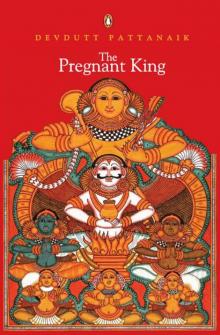 Pregnant King
Pregnant King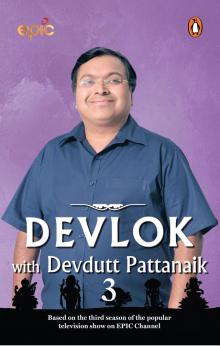 Devlok With Devdutt Pattanaik: 3
Devlok With Devdutt Pattanaik: 3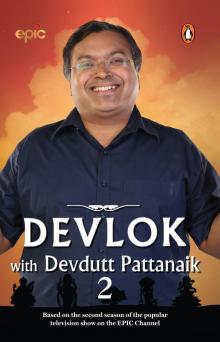 Devlok With Devdutt Pattanaik
Devlok With Devdutt Pattanaik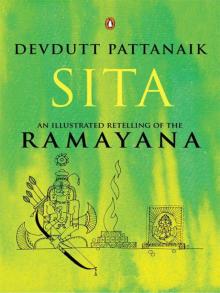 Sita: An Illustrated Retelling of the Ramayana
Sita: An Illustrated Retelling of the Ramayana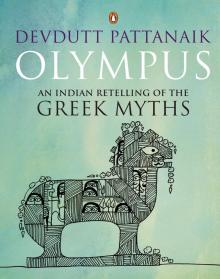 Olympus
Olympus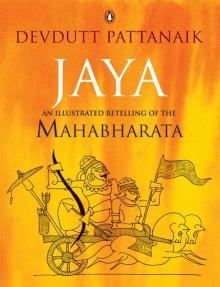 Jaya: An Illustrated Retelling of the Mahabharata
Jaya: An Illustrated Retelling of the Mahabharata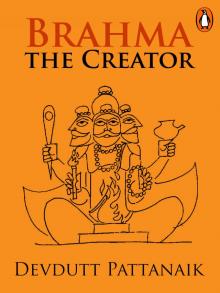 Brahma
Brahma